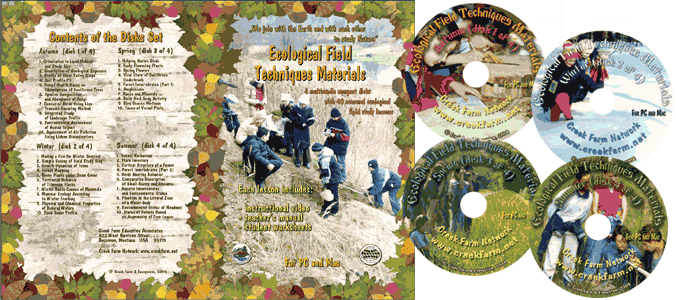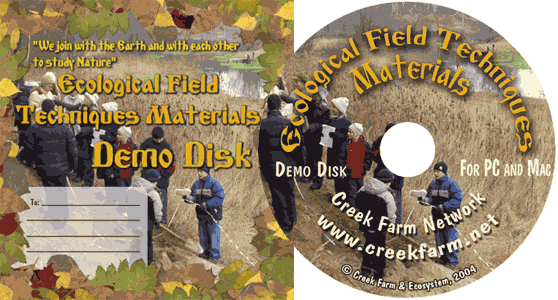|
| Our Field Ecology Center published more than
180 methodical materials for nature studies. Some of them are in English: |
|
|
|
Assessment of the Vital State of a Forest Based on Pine-tree
Analysis
© Alexsander S. Bogolyubov,
Yuri A. Buyivolov, Michael V. Kravchenko, Russia, 1999
© Michael J. Brody, 2003
 This manual contains a procedure
for environmental assessment of forests based on the analysis of the morphological state
of Scotch pine trees (Pinus sylvestris L). Key characteristics chosen as the main integral
criteria are: the degree of crown defoliation, needle discoloration, number of cones and
growth of end shoots. This manual contains a procedure
for environmental assessment of forests based on the analysis of the morphological state
of Scotch pine trees (Pinus sylvestris L). Key characteristics chosen as the main integral
criteria are: the degree of crown defoliation, needle discoloration, number of cones and
growth of end shoots.
This field study has instructional video
featuring real students conducting the ecological field techniques in nature. Each video
illustrates the primary instructional outcomes and the major steps in accomplishing the
task including reporting the results.
Introduction
In the last two decades, mass damage and degradation of forests has been recorded in
many European countries. Forest degradation is mainly caused by atmospheric pollution.
Acid rains, high concentrations of sulphur oxides and nitrogen oxides as well as ozone in
the air cause direct damage to plants; they lead to the worsening of state of forests.
The third session of the Executive Committee of the Convention on distant transboundary
transfer of air pollutants under the aegis of UNEP (1985) approved and launched the Programme
of International Cooperation on research and monitoring of air pollutant impact on forests.
The Programme is part of the Global System of Environmental Monitoring. The program is
based on the collection of comparable data about the state of forests at a national level
and the subsequent exchange of this data, aimed at a better understanding of the problem.
The given procedure is relatively simple and reliable to use so it can be successfully
applied in the practical environmental education of students. It is based on studies
conducted on constant sites and can be used for both long-term monitoring and individual
research.
The present procedure of study, monitoring and assessment of the vital state of forests
is based on the bioindication method. The method consists of an assessment of the
environmental status (general vital state of the forest) according to different
characteristics of the studied living organism (in our case, pine). In other words, the
indicator-species informs us about unfavourable environmental conditions by its
appearance: its vital state. What environmental factors cause a certain response of the
tree to unfavourable conditions is a separate, rather difficult question, which is not
touched upon when the given lesson is performed.
It is recommended to use Scotch pine (Pinus sylvestris L.) as a main
bioindicating species in the course of this research. If this species is not found in your
area, you can substitute another species of pine.
Pine trees are one of the best model species to serve as bioindicators. First of all,
the pine is very sensitive to even slight changes of environmental conditions, including
environmental pollution. Second, pine is widespread in many forested areas of Europe,
Asia, and North America; thus it is easy to find suitable study sites. It also simplifies
the problem of comparability of data collected in different regions. Pine is also a
convenient object for study by students due to the fact that pine is an evergreen tree and
produces only one shoot a year, which makes observations much easier. From a methodical
point of view, pine is a well-studied tree species.
The given task is divided into three stages:
Choice of sites and selection of trees for study.
Description of the general vital state (GVS) of trees.
Evaluation and interpretation of collected data, presentation of the study results.
The following items are required for the research: a compass, a measuring tape
(one for each team of students), field glasses and description forms (one per group of 2-3
students).
Choice of a site and selection of trees for conducting measurements
As a rule, all long-term studies, especially monitoring studies, are carried out at constant
sites. However, if a study takes place only once, it should be conducted at specific
fixed natural objects; their choice should be as random as possible. Thus, we reduce the
factor of a researcherТs arbitrariness and create the conditions for external control
and assessment for accuracy and reliability of collected data.
Choice of site location
A site for study of the vital state of trees should be situated in a relatively large
forest massif; its total area should be not less than 1 hectare (100m x 100m). The
site should be located in the heart of the forest and should not border the edges of the
forest, forest roads or paths. It is recommended that a site is located at a distance not
less than 25 meters away from the forest edges, roads or paths.
Selection of trees
It is necessary to make provisions for a random sample of trees, independent from the
researcher, while selecting trees for study. A system of random samples in scientific
research, when chosen subjects (in our case, trees) represent the general state of the
whole studied object (in our case, a forest), is called choosing a representative
sample. The following system of tree selection is...
This was only the first page from the manual and its full version you can see in the
Ecological Field Studies Techniques Video 4CD Set:
It is possible to purchase the complete set of 40 seasonal Ecological Field
Studies Techniques Video (in mpg format) in an attractive 4 compact disk set.
These compact disks are compatible with Mac and PC computers.
The videos are suitable for individual student or whole class instruction. To purchase the complete 4CD set
write to ecosystema1994@yandex.ru in a free form.

Ecological Field Studies Demo Disk:
We also have a free and interesting demonstration disk that explains our ecological field studies approach.
The demo disk has short excerpts from all the seasonal field study videos as well as sample text from all the teacher manuals.
The disk has an entertaining automatic walk through which describes the field study approach and explains how field studies meet education standards.
You can also download the Demo Disc from ecosystema.ru/eng/eftm/CD_Demo.iso.
This is a virtual hybrid (for PC and Mac computers) CD-ROM image (one 563 Mb file "CD_Demo.iso").
You can write this image to the CD and use it in your computer in ordinary way.
You also can use emulator software of virtual CD-ROM drive to play the disk directly from your hard disk.

|







